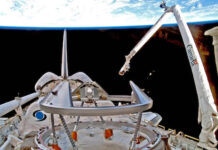
Posted by Heidi Schwartz
A new NASA-led study of “atmospheric river” storms from the Pacific Ocean may help scientists better predict major winter snowfalls that hit West Coast mountains and lead to heavy spring runoff and sometimes flooding. Atmospheric rivers—short-lived wind tunnels that carry water vapor from tropical oceans to mid-latitude land areas—are prolific producers of rain and snow on California’s Sierra Nevada mountains. The finding, published in the journal Water Resources Research, has major implications for water management in the West, where Sierra runoff is used for drinking water, agriculture and hydropower.
The research team studied how two of the most common atmospheric circulation patterns in the Northern Hemisphere interact with atmospheric rivers. They found when those patterns line up in a certain way, they create a virtual freeway that leads the moisture-laden winds straight to the Sierras.
Bin Guan of the Joint Institute for Regional Earth System Science and Engineering, a collaboration between NASA’s Jet Propulsion Laboratory (JPL) in Pasadena, CA, and the University of California Los Angeles (UCLA), led a team of scientists from NASA, UCLA and the National Oceanic and Atmospheric Administration (NOAA) on this research.
A moderate-sized atmospheric river carries as much water as the Mississippi River dumps into the Gulf of Mexico in an average week. When the river comes ashore and stalls over higher terrain, the water falls as snow or rain.
“Atmospheric rivers are the bridge between climate and West Coast snow,” said Guan. “If scientists can predict these atmospheric patterns with reasonable lead times, we’ll have a better understanding of water availability and flooding in the region.” The benefit of improving flood prediction alone would be significant. A single California atmospheric-river storm in 1999 caused 15 deaths and $570 million in damage.
Guan’s team used data from the JPL-developed Atmospheric Infrared Sounder (AIRS) instrument on NASA’s Aqua satellite, along with NOAA satellite data and snowpack data from the California Department of Water Resources. They looked at the extremely snowy winter of 2010-2011, when 20 atmospheric rivers made landfall.
AIRS was built and is managed by JPL for NASA’s Science Mission Directorate in Washington. Aqua is managed by NASA’s Goddard Space Flight Center, Greenbelt, MD. JPL is a division of the California Institute of Technology in Pasadena.














![[VIDEO] Get More for Your Business in Ardmore. Oklahoma](https://businessfacilities.com/wp-content/uploads/2024/02/maxresdefault-324x160.jpg)
